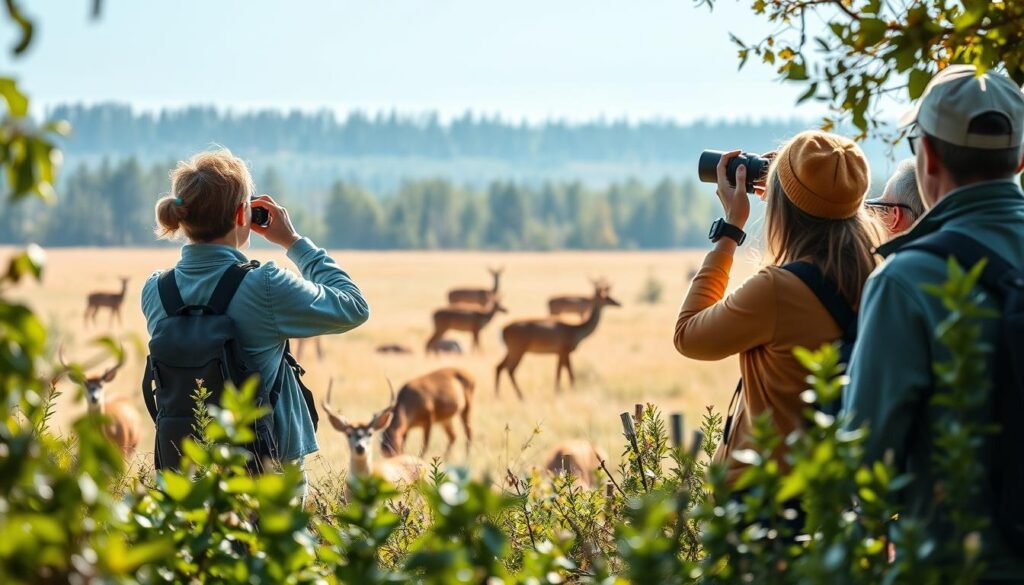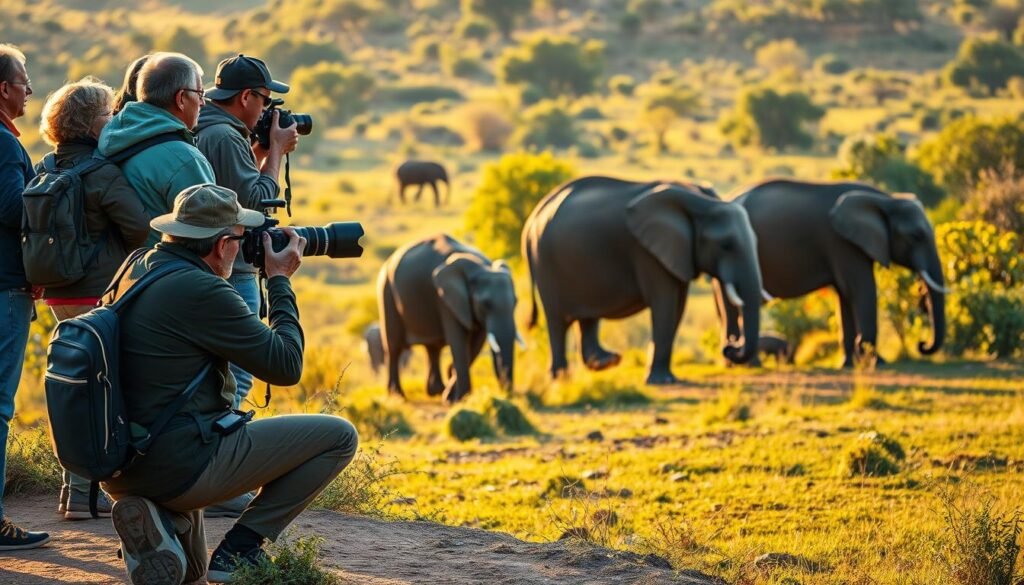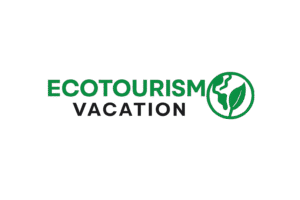Ethical Wildlife Tours: Travelers are now more aware of their environmental impact. This has led to a rise in demand for responsible travel experiences. Julia Carter, founder of Craft Travel, sees a big change. She notes a 270% increase in clients who want to help protect the environment during their luxury trips.
This growing interest in eco-friendly tourism shows a desire to protect animals and nature. By picking tours that focus on animal welfare and saving the environment, travelers can make a positive difference. They can help protect the places they visit.
Key Takeaways
- Travelers are increasingly prioritizing sustainability and conservation.
- Eco-friendly tourism can contribute to the protection of animals and ecosystems.
- Responsible travel experiences are becoming more popular.
- Conservation is a key consideration for luxury travelers.
- Choosing the right tour operator can make a significant difference.
The Importance of Ethical Wildlife Tours
As we learn more about our planet, the role of ethical wildlife tours grows. It supports conservation and helps people understand and love wildlife more.
What Is Ethical Wildlife Tours?
Ethical wildlife tours means watching and interacting with animals in a way that respects them. It focuses on responsible animal encounters. This ensures that tourism doesn’t hurt or stress the animals.
Liesel van Zyl, head of positive impact & product development at Go2Africa, stresses the need for audits. These audits help decide if a partner is ethical. This shows the importance of careful choices in tourism.
Key Principles of Ethical Practices
Ethical wildlife tours aims to protect wildlife habitats and support conservation. It also focuses on animal welfare. Tour operators who follow these principles help create sustainable wildlife viewing experiences. These experiences benefit the environment and local communities.
- Minimizing disturbance to wildlife and their habitats
- Supporting conservation projects and local communities
- Educating tourists about wildlife and conservation
- Promoting responsible wildlife viewing practices
Benefits for Wildlife and Ecosystems
Ethical wildlife tours has many benefits for wildlife and ecosystems. It supports conservation and promotes sustainable practices. This helps protect endangered species and natural habitats. It also gives local communities economic reasons to protect wildlife, helping ecosystems stay healthy.
“Responsible tourism practices can significantly contribute to the conservation of wildlife and their habitats, making it a vital component of modern conservation efforts.”
Here’s a table showing the economic benefits of wildlife tourism in different countries.
| Country | Economic Benefits from Wildlife Tourism |
|---|---|
| Kenya | $1.2 billion annually |
| South Africa | $2.1 billion annually |
| Tanzania | $1.5 billion annually |
Wildlife tourism can bring in a lot of money. This money can be used for conservation and to help local communities. This shows why ethical practices are so important in this field.
How Wildlife Tourism Impacts Conservation
Travelers now seek eco-conscious wildlife experiences more than ever. This shift highlights the importance of tourism in conservation. When done right, wildlife tourism can greatly help protect natural habitats and species.
Economic Contributions to Conservation
Wildlife tourism directly supports conservation through its economic benefits. Tourists visiting protected areas bring in money. This money funds important conservation work like fighting poaching and restoring habitats.
Many national parks and wildlife reserves need tourism dollars to keep going. The money from entrance fees and tours helps fund conservation projects. This helps protect endangered species and their homes.
| Conservation Area | Annual Tourism Revenue | Conservation Projects Supported |
|---|---|---|
| Masai Mara National Reserve, Kenya | $10 million | Anti-poaching units, community development |
| Galapagos Islands, Ecuador | $15 million | Habitat restoration, invasive species control |
| Yellowstone National Park, USA | $20 million | Wildlife research, habitat preservation |
Reducing Poaching Through Responsible Tourism
Responsible wildlife tourism helps fight poaching. By choosing ethical safari tours and supporting local communities, tourists help create jobs for conservation. This makes locals more likely to protect wildlife.
Tour operators who focus on sustainability also help. They might work with conservation groups to fund anti-poaching efforts. They also educate locals about why conservation is key.
Supporting Local Communities
Wildlife tourism benefits local communities by creating jobs and promoting conservation. When tourists learn about and support local cultures, they help people living with wildlife. This support can make locals more likely to protect their environment.
Community-based conservation projects, backed by tourism, offer new ways to make a living. They also help reduce conflicts between humans and wildlife.
Recommended Destinations for Ethical Wildlife Tours
The world is full of amazing places for ethical wildlife tours. Some spots are really making a difference. They offer unforgettable experiences and help protect wildlife.
Costa Rica: A Leader in Eco-Tourism
Costa Rica is known for its eco-tourism and wildlife protection. Its rainforests, culture, and wildlife are perfect for wildlife conservation vacations. Visitors can see the cloud forests of Monteverde and spot the resplendent quetzal.
Costa Rica’s tourism supports conservation. Many eco-lodges and tour operators help protect the environment.
Kenya: Safari with a Conservation Focus
Kenya is great for ethical wildlife photography tours. The Maasai Mara National Reserve is famous for its wildebeest migration. Tour operators in Kenya work with local communities and conservation groups.
The Galapagos Islands: Preserving Biodiversity
The Galapagos Islands have a unique ecosystem. The Galapagos National Park and Marine Reserve protect many species. Tourism here is managed to protect the environment.
| Destination | Conservation Efforts | Tourism Highlights |
|---|---|---|
| Costa Rica | Protection of rainforests and cloud forests | Spotting resplendent quetzals, exploring Monteverde |
| Kenya | Community-led conservation initiatives | Witnessing the wildebeest migration in Maasai Mara |
| Galapagos Islands | Strict protection of unique ecosystems | Observing endemic species, guided tours |
These places show how ethical wildlife tours can help. By visiting these spots, travelers support conservation. This helps protect our planet’s wildlife.
Selecting the Right Tour Operators
Choosing the right tour operator is key to a great wildlife tour. Eco-tourism has grown, but not all follow ethical standards. It’s important to pick an operator that cares for the environment and wildlife.
Criteria for Choosing Ethical Operators
Look for several things when picking a tour operator. Research their conservation efforts and how they protect wildlife. Also, check if they follow responsible tourism practices, like reducing waste and respecting habitats.
Louise Truman, founder of Plotpackers, combines science and her team’s knowledge. This ensures the tour is both fun and supports conservation.
Certifications to Look For
Certifications from known organizations can prove an operator’s credibility. Look for Tourism for Conservation or ethical tourism associations membership. These show they follow sustainable and responsible tourism.
- Certification from international conservation organizations
- Membership in local eco-tourism boards
- Adherence to global sustainable tourism guidelines
Reading Reviews and Testimonials
Reading reviews and testimonials is also vital. They give insights into the operator’s performance and environmental practices. Look for mentions of ethical whale watching trips or environmentally friendly wildlife tours to match your values.
By evaluating these factors, travelers can make smart choices. They can pick operators that help wildlife conservation and support local communities.
The Role of Wildlife Guides in Ethical Tourism
Wildlife guides do more than just share facts about animals. They learn how to keep tourism from harming the environment and animals. Cristian Asún, head of expeditions at The Singular Patagonia, stresses the need for guides to reduce animal stress during tours.
Training and Responsibility of Guides
Guides get extensive training to know about different species’ behavior, homes, and needs. This helps them lead tours that are both fun and safe for everyone. They make sure tourists don’t disturb the wildlife, supporting responsible animal encounters.
Guides also learn about the local ecosystem and why conservation is key. By teaching tourists about this, they help people understand the value of ethical wildlife tours in protecting nature.
The Impact of Local Knowledge on Tours
Guides with local knowledge make tours much better. They spot rare species and share cool facts about their habitats and behaviors. This local insight not only deepens tourists’ understanding but also promotes ethical wildlife tourism.
Local guides are also vital in exploring sensitive habitats without harming them. Their knowledge helps avoid protected areas, supporting conservation.
Best Practices for Tourists
When we explore wildlife habitats, it’s key to follow best practices. This makes our experience both sustainable and eco-friendly. As tourists, we have a big role in making sure our visits are ethical and don’t harm the environment.
Respect for Wildlife and Natural Habitats
It’s important to keep a safe distance from wildlife. Andrew Roberts, co-founder of EXP Journeys, says if an animal acts differently, it’s a sign we’re too close. This means staying physically far away and not doing things that disturb them, like feeding or making noise.
- Keep a safe distance from animals to avoid stressing them.
- Refrain from feeding wildlife, as it can alter their diet and behavior.
- Avoid making loud noises that could disrupt their natural habitats.

Adhering to Guidelines and Regulations
Tour operators and local authorities give guidelines to ensure tourism is done right. Following these guidelines is important. It helps make sure our visits are not only legal but also sustainable.
- Follow the instructions provided by your tour guides and local authorities.
- Be aware of and comply with local regulations and conservation efforts.
- Participate in activities that support conservation, such as wildlife monitoring or habitat restoration.
Supporting Local Communities
Helping local communities is a big part of ethical wildlife tourism. By supporting local economies and respecting their culture, we help make tourism better for everyone.
- Choose tour operators that have partnerships with local communities.
- Purchase goods and services from local providers.
- Respect local customs and traditions.
By following these best practices, we can make our wildlife tour experiences better. We also help protect wildlife and support local communities.
The Environmental Impact of Wildlife Tourism
Wildlife tourism is growing fast, raising concerns about its impact on nature. As more people visit natural places, we need to think about how to protect these areas. It’s important to find ways to lessen the harm caused by tourism.
Nick Pulley, founder of Selective Asia, says that focusing too much on popular wildlife spots can harm the environment. He believes we need to make wildlife tourism more sustainable.
Carbon Footprint Considerations
The carbon footprint of wildlife tourism is a big issue, with transportation being a major factor. Flights, in particular, produce a lot of emissions. To help, some tour companies offer carbon offset programs. This lets tourists pay to help reduce their carbon footprint by supporting environmental projects.
“The tourism industry must adopt more sustainable practices to reduce its carbon footprint. This includes not only offsetting emissions but also reducing energy consumption and promoting eco-friendly accommodations.”
| Carbon Footprint Sources | Estimated Emissions | Mitigation Strategies |
|---|---|---|
| Flights | High | Carbon offset programs |
| Accommodations | Moderate | Eco-friendly hotels, energy-efficient practices |
| Transportation (local) | Variable | Using electric or hybrid vehicles |
Waste Management Practices
Good waste management is key to reducing wildlife tourism’s environmental impact. Tour operators and places to stay are using different methods. These include cutting down on single-use plastics, recycling, and disposing of waste properly.
By using these methods, the wildlife tourism industry can lessen its environmental impact. This helps protect natural habitats. It’s a step towards making sure tourism benefits both local people and the environment.
The Future of Ethical Wildlife Tourism
New trends in travel are changing the face of ethical wildlife tourism. More people want to travel in ways that are good for the planet. They look for tours that are both fun and help protect wildlife.
Trends in Sustainable Travel
Traveling in a way that’s good for the planet is now common. People want to see wildlife without harming it. Ecotourism, including ethical wildlife photography tours and ethical whale watching trips, is very popular.
Technology is also key in making wildlife tourism better. Drones and remote cameras let people watch wildlife without disturbing it. This helps keep the animals’ natural behaviors intact.

Innovations Supporting Wildlife Conservation
New tech and green practices are vital for saving wildlife. Artificial intelligence and data analytics help track wildlife and meet conservation needs quickly.
There’s also a rise in community-based tourism. Local people help run wildlife tours. This way, tourism benefits everyone and connects visitors with the local area.
The future of wildlife tourism is bright. It will mix protecting wildlife with giving travelers great experiences. By using green practices and new tech, we can make sure tourism helps conservation.
Stories of Success in Ethical Wildlife Tourism
Responsible wildlife tours have made a big difference in conservation worldwide. Ethical wildlife tourism helps protect animals and their homes. It also helps people and wildlife live together better.
Case Studies of Impactful Tours
Many tour operators are helping conservation through their work. For example, Impactful Travel leads the way in ethical wildlife tourism. Sara Campanales from Impactful Travel talks about a special moment with gibbons in Thailand. She says it’s key to respect animals in their natural places.
Here are some key examples:
- Costa Rica’s national parks are better thanks to eco-tourism.
- Safari tours in Kenya have helped fight poaching and support local people.
- The Galapagos Islands are keeping their unique wildlife safe through careful tourism.
| Destination | Conservation Effort | Impact |
|---|---|---|
| Costa Rica | Protection of rainforests and wildlife | Increased biodiversity |
| Kenya | Anti-poaching initiatives | Reduction in poaching activities |
| Galapagos Islands | Sustainable tourism practices | Preservation of unique ecosystems |
Testimonials from Tourists
People who go on ethical wildlife tours often say it changed their life. “The encounter with gibbons in Thailand was a highlight of my trip,” says Sara Campanales. These experiences make people appreciate wildlife more and want to help protect it.
Here’s what others have to say:
“The guided tour in the Galapagos Islands was incredibly informative and helped me understand the importance of conservation.”
“Participating in a safari tour in Kenya was a thrilling experience that supported local communities and conservation.”
How to Advocate for Ethical Wildlife Tours
It’s key to support wildlife tourism that’s good for animals and the environment. Alisha Watson, head of relationships at Love to Explore, says it’s vital to back tourism that cares for animals and their homes.
Engaging with Conservation Efforts
Supporting groups and local communities that protect wildlife is a great way to help. This way, tourists can help keep animals and their homes safe.
Sharing Experiences and Knowledge
Sharing what you know about good wildlife tourism can really help. By doing this, you can inspire others to care for the environment too.
Promoting Awareness Online
Using social media to talk about good wildlife tourism can reach lots of people. By sharing your stories, you can help others support conservation and choose the right tour operators. This helps make tourism better for everyone.

















[…] ethical travel experiences helps protect nature, supports local businesses, and keeps cultural traditions alive. This way of […]